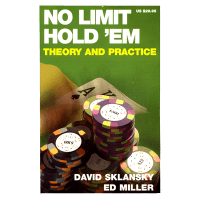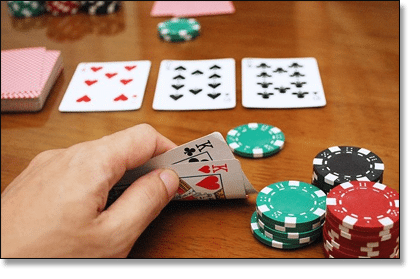Holdem Poker For Advanced Players

I have to say that it is an excellent companion to Ed Miller's superb work, Small Stakes Hold'em. What I love about Hold Em for Advanced Players is that it recalibrated my fundamentals which. In addition, the site boasts advanced poker tournament training for higher stakes players led by one of the biggest names in the game Nick Petrangelo, who has two poker courses dubbed “Winning. Tournament Poker for Advanced Players by David Sklansky. Poker players raised on video games, the Internet and MTV. Best known for both his. Small ball is an extremely advanced strategy and should only be used. David Sklansky & Mason Malmuth - Hold'Em Poker for Advanced Players - Free ebook download as PDF File.pdf) or view presentation slides online. A dual effort between David Sklansky and Mason Malmuth, this book touches on various advanced poker subjects for the Hold'em player. In this, the 21st century edition, psychology.
- Title:
- Hold'em Poker for Advanced Players, 21st Century Edition
- Author:
- David Sklansky and Mason Malmuth
- Publisher:
- Two Plus Two Publishing
- Date:
- 1999
- ISBN:
- 1-880685-22-1
- Pages:
- 332
- Price:
- $29.95
Reviewed by Nick Christenson, npc@jetcafe.org
July 17, 1999
Hold'em Poker for Advanced Players has certainly been oneof the most influential poker books ever written, it has literally changedhow people have played this game. Moreover, this book has, in large part, set the standard by which other poker books have been judged.Now, a much expanded new edition for the 21st century has been released.
The book starts with several short preliminary sections, includingthe Forward by expert player Ray Zee, the Introduction, and a sectioncalled 'Using This Book'. The reader is warned immediately that this book should not be read casually. It is intended as a text book on Texas Hold'em and will need to be studied as a text, not read as one would a novel, if the reader is to maximize the benefit of the material within.
Then, the first of eight sections begins, covering the play of the firsttwo cards. This includes the now famous hand ranking table. The authorsrecommend which sorts of hands to play in various positions but emphasizethat it is not sufficient to just play well before the flop to be awinning player. The second section covers various important conceptsabout which the Hold'em player must be aware, including Semi-Bluffing,Slow Playing, the Check Raise, Inducing Bluffs, and many more. Thethird section covers a wide variety of topics, including playing whena flush draw flops, playing trash hands, playing against a maniac, etc..Most of these sections were classics when they were written. They'reeven better now that they've been updated to more closely reflectthe sorts of games that are commonly found in card rooms today.
Sections four through six cover playing in all sorts of non-standard games, and this is the area where the book has been most greatly expandedsince its original printing. We learn about playing in loose games, including so-called 'No Fold'em' games, playing short handed, and playing in otherunusual circumstances. All of this information is very interesting andhas been updated to be much more closely aligned to the sorts of gamescommonly found today. Of course, there is much more that could be saidon some of these topics, such as playing in spread limit games, but the authors cover a lot of territory already. I especially like thenew sections that cover considerations in playing some especially trickystarting hands, like AQoff.
Part seven includes commentary on other skills the successful Hold'emplayer will want to possess, such as reading hands and applying psychology.Finally, the last section, Questions and Answers, provides a quiz coveringmuch of the material presented in earlier chapters so the reader can testthemselves to see whether they've understood what the authors were tryingto communicate. I've always felt that this was one of thestrongest sections of this book and other publications by Two Plus Two, and I'm glad to see that it has been greatly expanded in the most recent edition. The book ends with someconcluding remarks, an appendix on calculating probabilities, and a glossary.


Of course, Sklansky and Malmuth have never shied away from controversy.There was plenty for Hold'em players to debate in the first edition ofthis book, and there is certainly much one could fairly argue about inthis edition. Although I wouldn't compare my strategic understandingof the game to the authors, there are strategies suggested in this bookthat I'm not certain are optimal, and I'm sure many people will argue theminutia of these many times over. However, I'm less interested in thespecific merit of the play of a single controversial hand than I am in the strategic concepts the authors are trying to teach. While I might quibble about whetherthat strategic concept is applicable in an example that they provide, I never get the feeling that the strategic concept itself is questionable. One of the great things about Texas Hold'emis that there are so many possible ways to play a given hand, and thatgreat players can disagree on these points. The way one can tell a greatplayer from a mediocre one is whether they can accurately read thesituation and take into account the strategic concepts that need to be applied at the moment, much more so than whether they bet, raise, checkor fold. One would be well advised, in my opinion, to keep thisin mind while reading this book.
Clearly, this book is a classic, and I doubt there are very many successfullimit Texas Hold'em players playing today who do not own a copy of oneof the earlier editions.Certainly, those that plan to play Hold'em well should own a copy of this work and read it several times. The big question is whether owners of previous revisions of this book should upgrade to the21st Century Edition. Note that this is the third update of this work,the original was published in 1988, it was updated in 1994, and thecurrent version was released in the summer of 1999. I have only the 1988 and 1999 editions, so I can only speak to those.
By my count, 150 pages have been added to the 182 page 1988 edition.In addition to new sections, there are minor changes to reflecthow the game has evolved over the years and to emphasize concepts thatcaused some conclusion in earlier editions. Overall, given the changes thathave been made to the 21st Century Edition from the first edition, Iwould recommend that those people who are serious about their Hold'emgame and have read the 1988 edition upgrade their copies of this book.Although I do not have enough information to make the same claim forthe 1994 edition, I wouldn't be at all surprised if it was worth upgrading from the second edition as well.
Capsule:
Hold'em Poker for Advanced Players is one of the classicsof the poker literature. This book is extremely well written, and it'shard for me to believe that many players are likely to mastertoday's games without having read and studied this text. Further, the21st Century Edition is, in my opinion, enough of an improvement overthe first edition that those who have already read the 1988 version should buy and read the new edition as well.
Note: I received a free review copy of this book from Two Plus Two Publishing. I have no other interest, financial or otherwise, inthe success of this book.
Click here to return to the index of reviews.
Starting Hand Selection:Chen Formula : Sklansky Starting Hand Groups
The Sklansky & Malmuth starting hands table.
| Group | Hands |
|---|---|
| 1 | AA, AKs, KK, QQ, JJ |
| 2 | AK, AQs, AJs, KQs, TT |
| 3 | AQ, ATs, KJs, QJs, JTs, 99 |
| 4 | AJ, KQ, KTs, QTs, J9s, T9s, 98s, 88 |
| 5 | A9s - A2s, KJ, QJ, JT, Q9s, T8s, 97s, 87s, 77, 76s, 66 |
| 6 | AT, KT, QT, J8s, 86s, 75s, 65s, 55, 54s |
| 7 | K9s - K2s, J9, T9, 98, 64s, 53s, 44, 43s, 33, 22 |
| 8 | A9, K9, Q9, J8, J7s, T8, 96s, 87, 85s, 76, 74s, 65, 54, 42s, 32s |
| 9 | All other hands not required above. |
This table comes from the book Hold 'em Poker for Advanced Players by David Sklansky and Mason Malmuth.
This is a strategy book for limit Hold'em, but the starting hand groups do have some practical use in no limit Hold'em.
What is the Sklansky and Malmuth starting hands table?
The table is a general ranking of hands in Texas Hold'em.
The Sklansky and Malmuth starting hands table groups together certain hands in Texas Hold'em based on their strength. Starting with the strongest set of hands that you can be dealt in group 1, the hands get progressively weaker working down the table until the virtually unplayable hands in group 9.
The rough idea is that a hand in one group has roughly the same value and can be played the same way preflop as any other hand in that group.
How to use the starting hands table.

In their book, Sklansky and Malmuth provide some in-depth guidelines for starting hand strategy in limit Texas Hold'em using this table. Unfortunately, I'm not going to work out any guidelines for you for the NL Hold'em game using this table because:
- It would be quite a tricky job.
- It would be difficult to remember and implement.
- Like any starting hand strategy, it would have its flaws.
- You should avoid using strict guidelines and set rules as much as possible during play.
So really there is not a lot to take away from this table from a purely strategic perspective. Nonetheless it's interesting to see how specific starting hands compare to one another based on their preflop value.
Max Games Texas Holdem Poker
If you're really after a starting hand strategy guideline, try the Chen Formula.
Sklansky and Malmuth hand rankings evaluation.
Although it's a very popular hand group rankings table, it's not going to do you too much good to learn the whole thing off by heart. In my opinion, the real value of this table is being able to see how different starting hands can be grouped together and ranked based on their value before the flop.
Hold'em Poker For Advanced Players
For other useful charts and tables, see the odds charts page from the Texas Hold'em tools section.
Texas Holdem Poker Play
Go back to the awesome Texas Hold'em Strategy.
Holdem Poker For Advanced Players
Comments